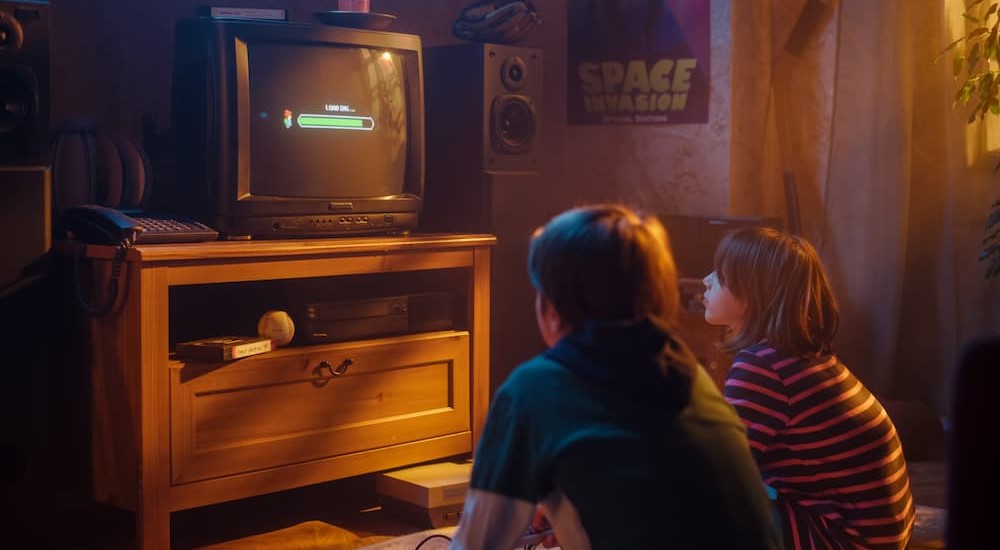The Start of It All
For all the glitter and glamor of arcades, to the avid arcade gamer came the wish of bringing arcade-quality games to the game consoles that sat tucked under their parent’s entertainment centers. To say there was a divide between what could be considered arcade quality and what people were receiving at home would be an understatement. One look at Pac-Man in its original arcade form from 1980 against what people received on their Atari 2600 console in 1982…disgusting.
Snafus like home console ports of arcade games would attribute to the Video Game Crash of 1983, but ultimately, it wouldn’t be until around the mid to late-1990s that arcade and home games reached a form of parity through the advent of 3D accelerator cards for home computers and game consoles like the Sega Dreamcast. However, I’m getting too ahead of myself, so let’s take a real step back and take a closer look at what was happening in the realm of home entertainment while the arcade was off doing something entirely different.
Blinking Lights and Imagination
When you think about the first home console, your mind might immediately go to the Atari 2600. While in the same ballpark, you have to go further back. The first gaming console plugged into the living room television was the Magnavox Odyssey. The Magnavox Odyssey was launched over fifty years ago, in 1972. The graphics on the Magnavox Odyssey were just lighting on a screen you manipulated with a rather bizarre-looking controller with dials on either side. Lights? How could you make a racing game out of solid shapes of light? The answer, my friend, is overlays and a LOT of imagination.
Place one of those plastic overlays over your screen, and you’re in business. As simplistic as it was, it was revolutionary and birthed the first home racing game: Wipeout. A plastic overlay on your screen that resembles a race track sets the stage, while the block of light you control is your car. Put those together, and you are off to the races. Imagination was key, and the rules of the game, scoreboard, and any other information we take for granted were all left up to the humans playing the game to figure out.
Everyone’s Favorite: Atari
Fast forward to the late 1970s, and the Atari 2600 hits the scene. Imagination was still a virtue for those playing Atari games at the time, but there was nothing else like it, so it was the best thing since sliced bread. Atari had already dove into the realm of racing games with some arcade titles such as Gran Trak 10, Roadblasters, Night Driver, and the like, but it was now time to put their money where their mouth was and deliver a proper home console racing game.
Several racing games hit the scene throughout the Atari 2600’s life, including the renowned Pole Position, Dragster, Street Racer, and many others. Pole Position is a personal favorite of mine for its pseudo-3D look that gave the illusion of a three-dimensional race track, albeit these artistry tricks were nothing but illusions and some extreme know-how of the hardware at hand. Simplistic graphics aside, the sprites on the screen could at least resemble vehicles, but are you noticing a trend here? Where are the licensed cars? For that, we need to go even further, past the video game crash of 1983 and into the world where Nintendo and Sega began to overtake the gaming industry.
That Car Looks Familiar… (1985-1993)
The ‘80s Gets “Most Triumphant”
We now enter the age that birthed modern gaming as we know it. At this time, Japanese video game manufacturers cleaned up shop and reintroduced Americans to the new age of the industry to combat the market crash in the early 1980s.
Even if you’re not a gamer, you’ve heard of Mario, everyone’s favorite Italian plumber. While Mario was introduced in 1970, sporting the name ‘Jump Man’ in Nintendo and Shigeru Miyamoto’s legendary Donkey Kong, it was on the Nintendo Entertainment System (NES) where Mario became—quite literally—a household name. This same game console introduced some of the finest racing games that are still revered to this day, and in its earliest days, there was Excitebike.
Excitebike wasn’t the only racing game on the platform. The esteemed Italian automotive manufacturer lent their likeness to a popular racing game released on Nintendo’s first home console in 1987: Rad Racer. Fun fact: although published by Nintendo in the United States, the game was developed by Square, who you may recognize as Square Enix—the legendary creators behind best-selling franchises like Final Fantasy.
Rad Racer had the niche of being one of the earliest examples of proper automotive likeness licensing on the home console. The vehicle looks identical to the one in Outrun – a critically-acclaimed 80s arcade racing game that didn’t acquire the proper likeness. But in Rad Racer, you aren’t left to your own volition––you are driving a Ferrari… That’s right, you! The Ferrari in mention is a GTB Turbo, which was one of the most sought-after Ferrari vehicles when it launched, and had a lifespan on the market lasting between 1986 and 1989. Both OutRun and Rad Racer were released within this time. Ferrari wasn’t the only one licensing out their likeness around this time, too, as there’s one rather obscure example I’d like to discuss.
Ford Had Different Plans…
Ford saw the advent of home technology in a different way. In some ways, Ford made the best use of what technology had to offer at the time. Were Ford vehicles in video games? Yes, but it was far more than that. Ford used to offer mail-order software, sometimes found at official Ford dealerships. This software was originally in the form of floppy discs before swapping over the CDs towards the end of this program––a program that acted as both a driving simulator and a visual showroom.
The idea was to breathe new life into shopping for a vehicle, and while it wasn’t like today, where you could place a purchase through a web browser, the software was more so meant to teach you about Ford’s lineup that year, including specs, images, videos, and, my favorite part, the driving simulator. Before computers could properly display real-world imagery, the pictures of the Ford vehicles were artist renditions––and they look beautiful, in a charming, pixelated kind of way––especially with the release of Ford Simulator II in 1989.
I’ll tell you now, the simulator portion isn’t accurate to real-world driving and doesn’t give you a true feeling for what each vehicle could and couldn’t do. Today, these pieces of software are the quintessential term for the word “gimmick.” At the time, it was novel yet neat, but it was nothing but the information on each vehicle that was the most crucial tidbit to note when visiting your local Ford dealership.
The excellent retro-tech YouTuber LGR has extensively detailed Ford Simulator programs, including Ford Simulator II and Ford Simulator 7.0; the latter was released in 1996. While you’re at it, you should also check out his videos on a few other racing games from the time, including one from Car and Driver in 1992. This perfectly leads us into the next chapter in our story, the glorious 1990s.
Early Computer Gaming
Do you use a PC with Windows? The precursor to the modern-day Windows Operating System was a glorified text command prompt-esque OS called MS-DOS. MS-DOS, like Windows machines today, and the game consoles in living rooms at the time, could play games, and with the right hardware, these games could be fantastic. The install base on home computers wasn’t as prolific as the number of kids playing Nintendo consoles back in the day, but computer gamers were treated to some great games, including one called Test Drive.
Test Drive was released back in 1987 on numerous computer platforms at the time ranging from MS-DOS machines to the Apple II and more. This racing game grew large appeal because of its licensing with five of the best supercar manufacturers and the vehicles they allowed these drivers to control. Among the selection of vehicles were the likes of the aforementioned Testarossa, a Porsche 911, and many more. The Duel: Test Drive II would follow this up a couple of years later and was fundamentally a more complete package throughout, and this was the first of the Test Drive franchise to hit home consoles.
Although the Corvette was featured in games like Test Drive, Vette was released on home computers running MS-DOS in 1989, and the game focused on one type of vehicle. The game places you in the driver’s seat of a Corvette––either stock, the ZR1 model, with a Twin Turbo engine, or the Callaway Sledgehammer Corvette––a historic, powerful, and especially fast Corvette from the late ‘80s that you’ve likely never seen in real life. In Vette, you drive at high speeds in what was one of the first open-world racing games invented.
This is something many people don’t think about, but driving games and open-world designs were a match made in heaven, as driving on roads is rarely done in one spot for too long, and having the ability to go where you want when you want to, was an appealing prospect for many. The influence behind the open world, in mention: San Francisco. Seeing real-world locations, streets, and monuments gave this game a sense of placement and grounding within the real world. Even in the early days, something was fascinating about seeing things we’re used to seeing in our world being translated into a digital space.
A Fondly Remembered Era
When older gamers think back to the early days of gaming, they’re transported back to a time before constant online updates, microtransactions, and general live-service gaming. To many, this was the golden age of gaming, and from a consumer-friendly perspective, this may as well be the case. However, it’d be foolish to agree that video games were piqued in the early days of home gaming––some of the very best gaming experiences, including ones we still play today, were introduced to the masses when 3D polygons took over.
I believe you can’t compare the two eras of gaming head-to-head because you can’t have one without the other––the evolution of the game industry is a tricky one, but also one that’s easy to predict if you sit down and look at the market trends. The modern age of gaming, which many of you were introduced to the world of video games through, is what I’ll be talking about in part three of our discussion on the history of cars in video games, so stay tuned!





